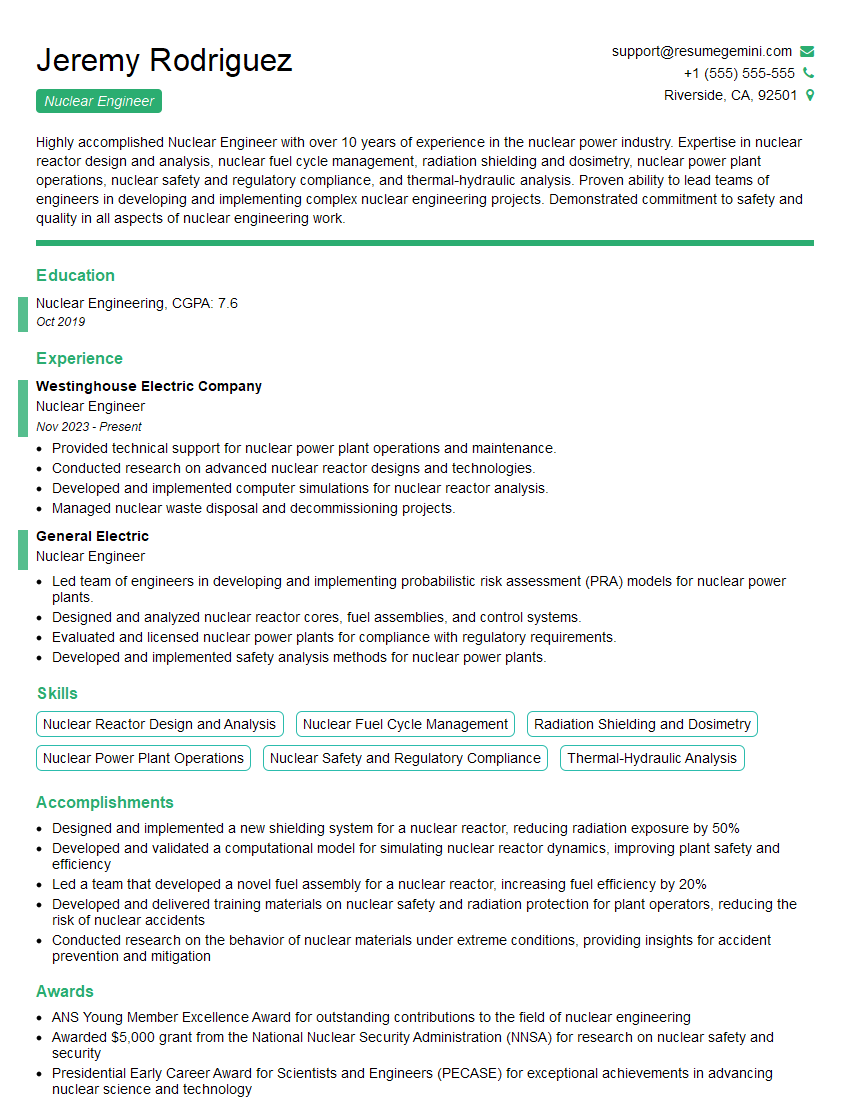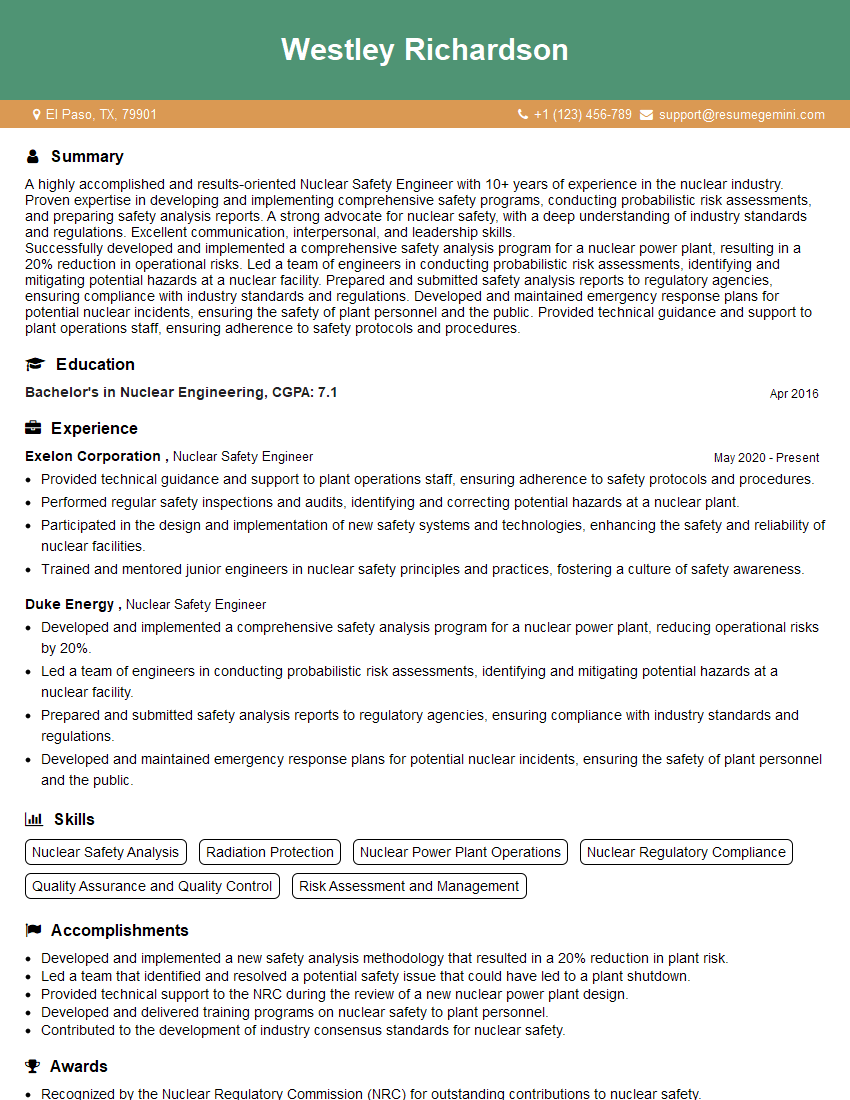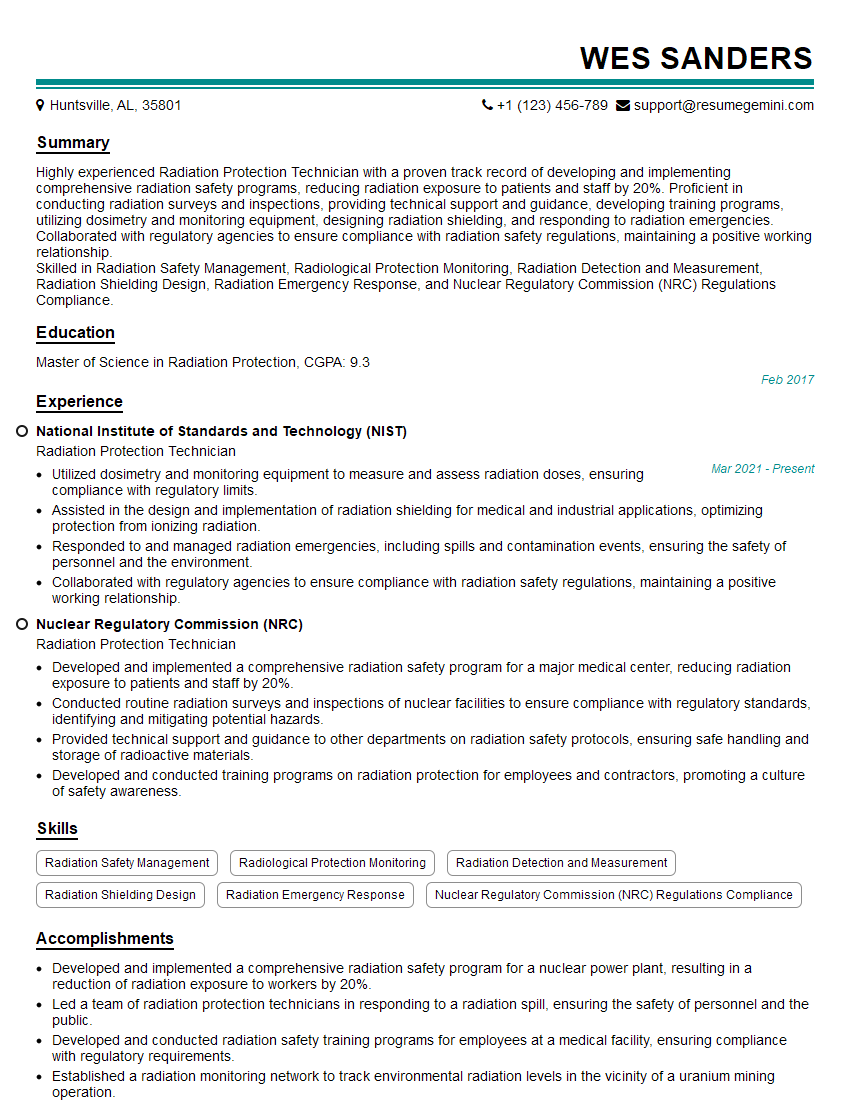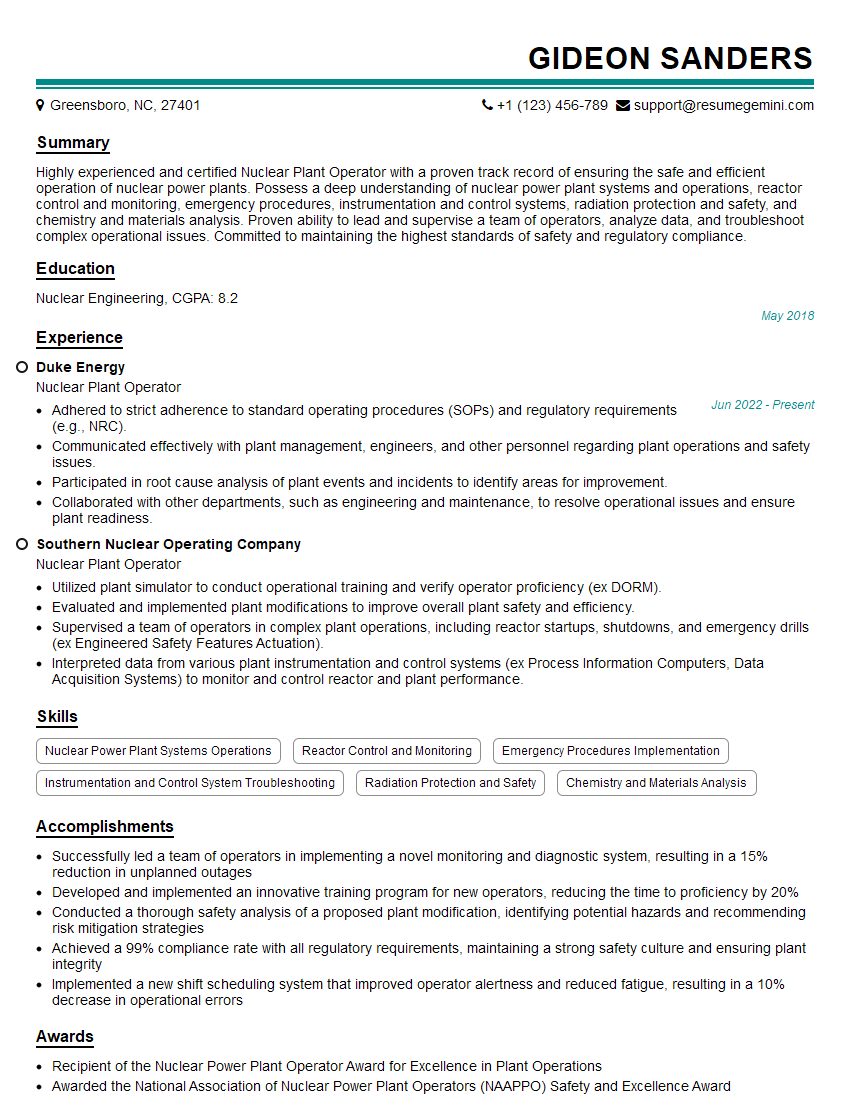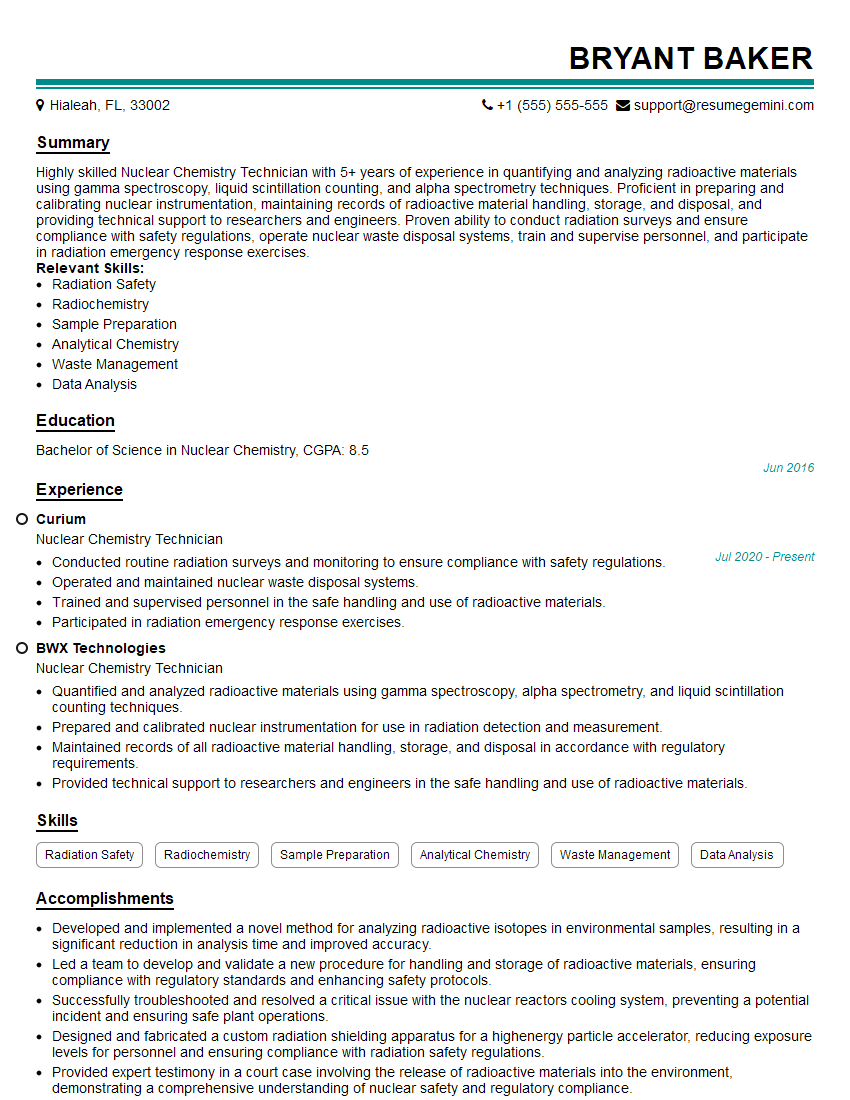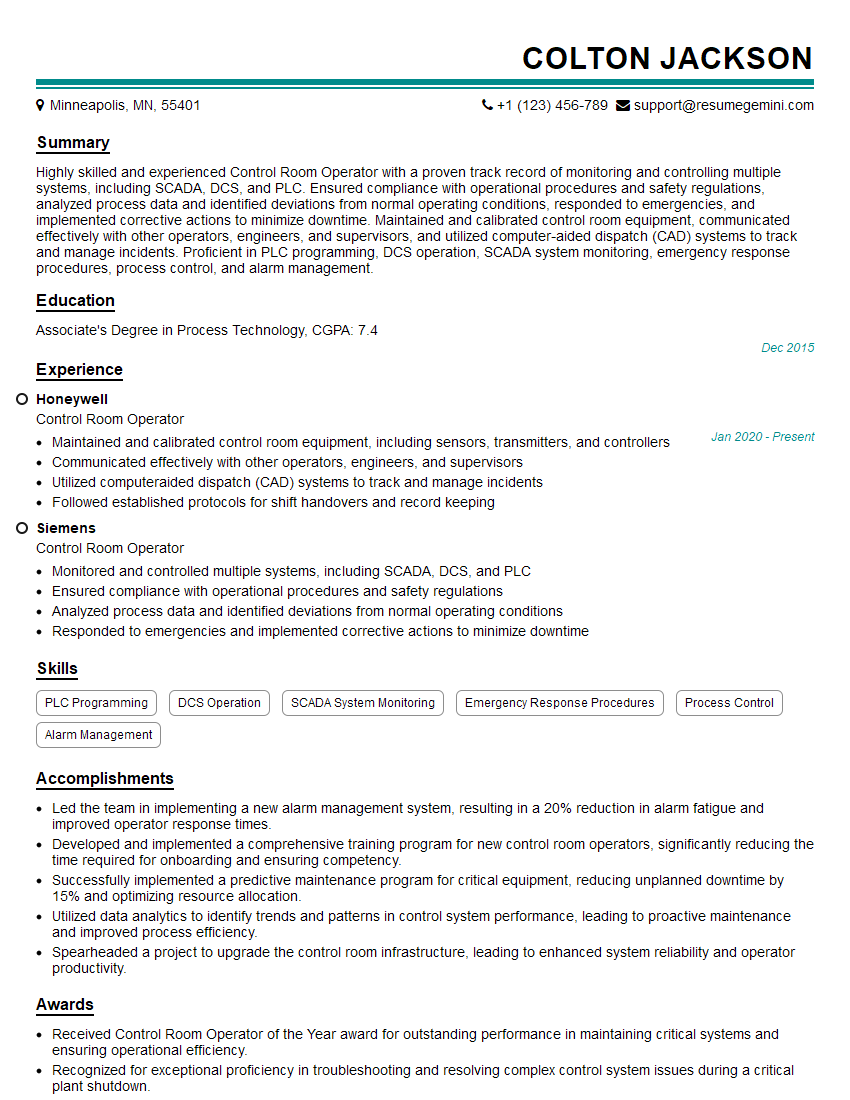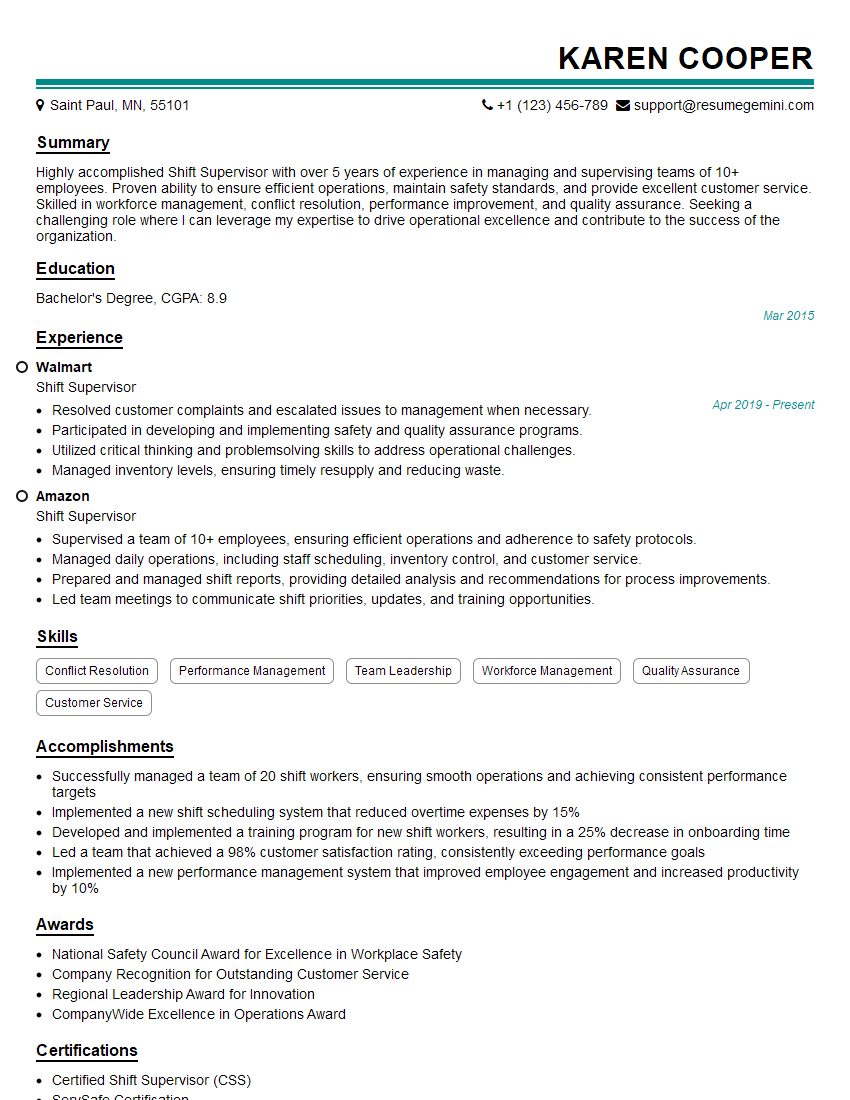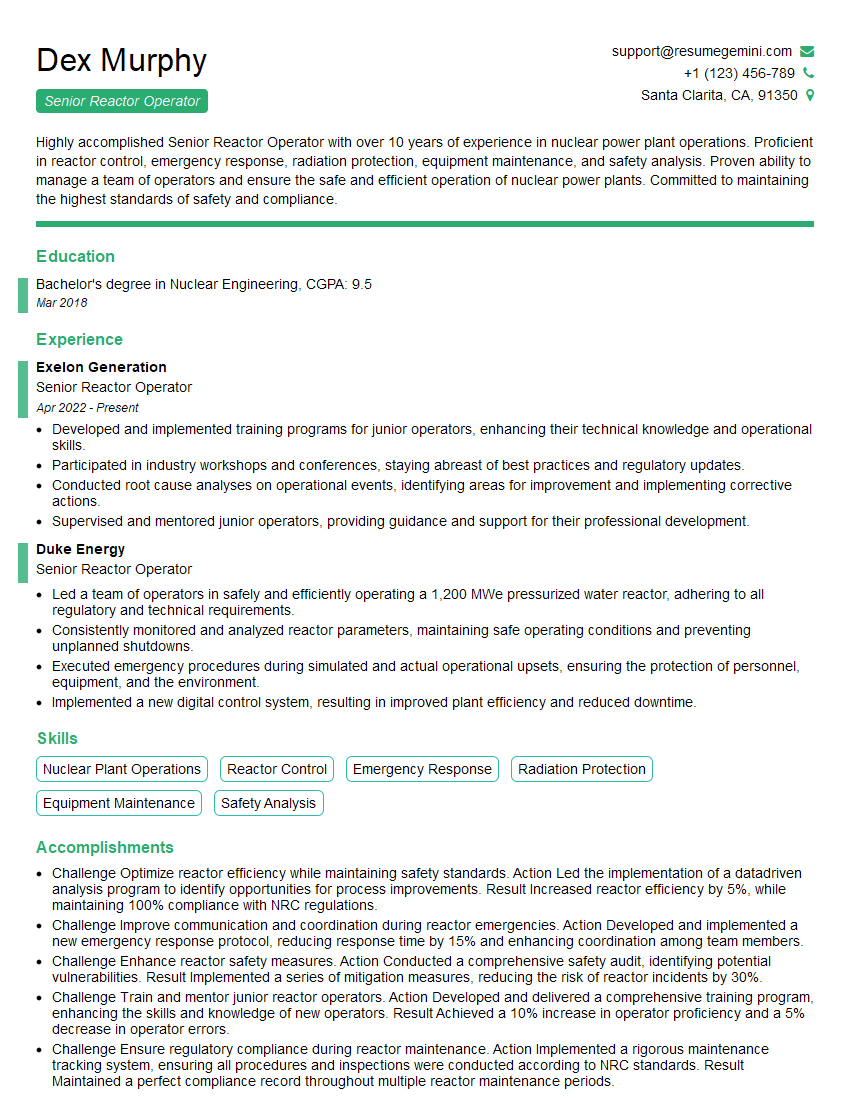Preparation is the key to success in any interview. In this post, we’ll explore crucial Nuclear Power Plant Systems Operations interview questions and equip you with strategies to craft impactful answers. Whether you’re a beginner or a pro, these tips will elevate your preparation.
Questions Asked in Nuclear Power Plant Systems Operations Interview
Q 1. Describe the process of reactor startup and shutdown.
Reactor startup and shutdown are carefully controlled processes ensuring safe and efficient operation. Startup involves gradually increasing the reactor power from zero to the desired operating level, while shutdown is the reverse, bringing the reactor to a safe, subcritical state.
Startup: This begins with inserting control rods fully into the core to ensure the reactor is subcritical (meaning the chain reaction is not self-sustaining). Then, the primary coolant system is started and brought to operating temperature and pressure. Control rods are slowly withdrawn in a controlled manner, increasing the neutron flux and initiating a chain reaction. Power increases gradually, monitored constantly by operators using various instruments like neutron detectors and temperature sensors. The process is slow and meticulous, with safety systems constantly monitoring parameters.
Shutdown: This process is initiated by inserting the control rods fully into the reactor core. This quickly reduces the neutron flux, stopping the chain reaction. The primary coolant system continues to circulate to remove decay heat (heat generated from radioactive decay of fission products). This decay heat is significant even after shutdown and requires cooling for several days or even weeks. The reactor is considered safely shut down once the decay heat is effectively managed and the reactor core is fully cooled.
Think of it like starting and turning off a powerful engine; you wouldn’t just slam the gas pedal or abruptly cut the fuel. Careful control and monitoring are essential throughout the entire process.
Q 2. Explain the function of the Emergency Core Cooling System (ECCS).
The Emergency Core Cooling System (ECCS) is a crucial safety system designed to prevent core damage in the unlikely event of a loss-of-coolant accident (LOCA). A LOCA occurs if a break or rupture in the primary coolant system leads to a significant loss of coolant. This loss of cooling could potentially lead to fuel melting (a meltdown).
The ECCS comprises several subsystems that automatically inject coolant into the reactor core, maintaining sufficient cooling to prevent a meltdown. These subsystems may include high-pressure injection systems, low-pressure injection systems, and accumulator tanks. High-pressure systems use pumps to inject coolant when system pressure is still relatively high. Low-pressure systems take over once the pressure drops. Accumulator tanks store coolant under pressure which is automatically released when pressure falls below a certain level. The ECCS is designed to be redundant and diverse, meaning there are multiple independent systems to ensure reliable cooling in a LOCA. This redundancy is vital to mitigate the risk of failure in a critical situation.
Imagine a car’s emergency brake system; it’s not used frequently, but when needed, it’s vital to prevent catastrophic failure.
Q 3. What are the different types of nuclear reactors and their key differences?
There are various types of nuclear reactors, each with unique characteristics and applications. The key differences lie in the type of fuel, coolant, moderator, and reactor design.
- Pressurized Water Reactor (PWR): Uses water as both coolant and moderator. Water is kept under high pressure to prevent boiling. Most common type globally.
- Boiling Water Reactor (BWR): Uses water as both coolant and moderator. Unlike PWRs, water is allowed to boil in the reactor core, generating steam directly to drive turbines.
- CANDU Reactor (Canadian Deuterium Uranium): Uses heavy water (deuterium oxide) as both coolant and moderator, and natural uranium as fuel. Operates at lower pressure than PWRs and BWRs.
- Pressurized Heavy Water Reactor (PHWR): Similar to CANDU, but often with enriched uranium fuel.
- Fast Breeder Reactor (FBR): Uses a liquid metal (like sodium) as coolant and doesn’t require a moderator. These reactors can breed more fissile material than they consume, improving fuel efficiency. They are currently less common.
The choice of reactor type depends on factors like fuel availability, cost, safety requirements, and operational characteristics.
Q 4. How does the control rod system regulate reactor power?
The control rod system is the primary mechanism for regulating reactor power. Control rods are made of neutron-absorbing materials, like boron or cadmium. By inserting or withdrawing these rods into the reactor core, the rate of the nuclear chain reaction is controlled.
Insertion: Inserting the control rods absorbs neutrons, reducing the number available to sustain the chain reaction. This decreases the rate of fission and consequently reduces reactor power.
Withdrawal: Withdrawing the control rods increases the number of neutrons available for fission, increasing the chain reaction rate and thus raising reactor power.
The control rods’ position is precisely controlled by sophisticated automated systems and human operators. They constantly monitor reactor power, ensuring it remains within safe operating limits. Imagine adjusting the gas pedal in a car—control rods function similarly, regulating the ‘speed’ of the nuclear reaction.
Q 5. Describe the safety systems in place to prevent a meltdown.
Multiple safety systems are implemented to prevent a meltdown, working in layers to provide defense in depth. These include:
- Emergency Core Cooling System (ECCS): Already described above.
- Reactor Protection System (RPS): This system continuously monitors reactor parameters like power, temperature, and pressure. If any parameter exceeds pre-set limits, the RPS automatically shuts down the reactor by inserting control rods.
- Containment Building: A robust structure designed to contain radioactive materials in the event of an accident, preventing their release to the environment.
- Safety Valves and Relief Valves: These are pressure relief devices designed to prevent excessive pressure buildup within the primary coolant system.
- Diverse and Redundant Systems: Multiple independent systems are used to perform critical functions, ensuring that if one system fails, others can still function.
The design incorporates multiple barriers and safety features to make a meltdown extremely unlikely. Each system acts as a backup for others, offering layers of protection.
Q 6. Explain the principles of radiation protection.
Radiation protection is based on the principles of minimizing exposure to ionizing radiation, which can damage living tissue. The key principles are:
- Time: Minimize the time spent in the vicinity of radiation sources.
- Distance: Increase the distance from the radiation source, as radiation intensity decreases rapidly with distance (inverse square law).
- Shielding: Use shielding materials (like lead, concrete, or water) to absorb radiation.
These principles are applied in the design of nuclear power plants, the handling of radioactive materials, and the training of personnel. Think of it as a layered defense strategy, minimizing exposure from multiple angles.
Q 7. What are the different types of radiation and their effects?
Ionizing radiation comes in several forms:
- Alpha particles: Relatively heavy, positively charged particles. Easily stopped by skin or a sheet of paper. Internally hazardous if ingested.
- Beta particles: Lighter, negatively charged particles. Penetrate further than alpha particles, but can be stopped by a thin sheet of metal.
- Gamma rays: High-energy electromagnetic radiation, highly penetrating and requiring thick shielding (like lead or concrete) for protection.
- Neutrons: Uncharged particles. Highly penetrating, requiring specialized shielding.
Effects of radiation exposure depend on the type and amount of radiation, as well as the duration and part of the body exposed. High doses can cause acute radiation sickness, while lower doses over long periods can increase the risk of cancer.
Q 8. How do you monitor and control reactor coolant temperature and pressure?
Reactor coolant temperature and pressure are meticulously monitored and controlled to ensure safe and efficient operation. Think of it like maintaining the perfect temperature and pressure in a high-pressure cooker – except this cooker generates electricity!
Monitoring: We utilize a network of sensors strategically placed throughout the reactor coolant system (RCS). These sensors continuously measure temperature and pressure at various points, transmitting data to a central control room. This data is displayed on sophisticated control panels and analyzed by plant operators. For example, we monitor the temperature at the reactor vessel outlet, the pressurizer (which maintains pressure), and various points in the steam generators.
Control: Maintaining the desired temperature and pressure involves manipulating various systems. Let’s say the temperature starts to rise. We might increase the flow of coolant through the RCS to carry away more heat. If pressure gets too high, we can open a pressure relief valve to vent some steam. Conversely, if temperature or pressure drops, we can adjust control rod positions to increase the nuclear reaction rate, or use auxiliary heaters to add heat to the system.
These processes are often automated, but plant operators constantly monitor and oversee the systems, making adjustments as needed. Safety systems are also in place to automatically shut down the reactor (scram) if parameters exceed predefined limits, safeguarding against potentially hazardous situations.
Q 9. What are the procedures for handling a loss of coolant accident (LOCA)?
A Loss of Coolant Accident (LOCA) is a serious event involving a breach in the reactor coolant system, leading to a rapid loss of coolant. Imagine a large hole suddenly appearing in your pressure cooker – the pressure and temperature would plummet, potentially leading to catastrophic failure. Our procedures are designed to mitigate this risk.
Emergency Core Cooling System (ECCS): This is the primary defense against a LOCA. The ECCS automatically injects coolant into the reactor core to prevent fuel overheating and melting. There are typically several independent ECCS subsystems to enhance reliability. Think of it as multiple backup water sources to keep the core cool.
Containment Isolation: The containment building is immediately isolated to prevent the release of radioactive materials. This is like sealing off a compromised area to prevent further damage.
Operator Actions: Plant operators follow a strict set of procedures, including monitoring parameters, initiating emergency systems, and communicating with regulatory bodies. Their training focuses on swiftly and effectively managing such scenarios. Extensive simulations and drills prepare them for these emergencies.
Post-Accident Actions: After the initial response, efforts focus on stabilizing the reactor, assessing the damage, and repairing the breach. This may involve complex recovery operations, often spanning days or even weeks.
Q 10. Describe the process of refueling a nuclear reactor.
Refueling a nuclear reactor is a complex and carefully planned operation, typically performed every 18-24 months. Imagine replacing the batteries in a giant, highly radioactive flashlight! The process is time-consuming and requires meticulous attention to safety.
Shutdown and Decay Heat Removal: First, the reactor is safely shut down and the decay heat (heat generated by radioactive decay) is effectively removed. This is crucial to reduce radiation levels and ensure worker safety.
Spent Fuel Removal: Using specialized equipment, the spent fuel assemblies (which have been used to generate power) are carefully removed from the reactor core. These assemblies are highly radioactive and require robust shielding and handling procedures.
New Fuel Loading: Fresh fuel assemblies are then inserted into the core, following a specific pattern designed to optimize power distribution and fuel utilization. The process involves precise positioning and verification.
System Inspection and Maintenance: During the outage, routine inspections and maintenance tasks are performed on various reactor systems, improving efficiency and safety. This is like performing a thorough service on your car.
Start-up and Testing: Once refueling and maintenance are complete, a careful startup and testing phase ensures the reactor operates safely and efficiently before returning to normal power generation.
Q 11. Explain the importance of maintaining proper water chemistry in the reactor.
Maintaining proper water chemistry within the reactor is paramount to preventing corrosion, minimizing radioactive contamination, and ensuring the long-term integrity of the reactor system. Think of it as keeping your car’s engine oil clean – crucial for optimal performance and longevity.
Corrosion Control: Specific chemicals are added to the water to control pH and inhibit corrosion. This prevents the buildup of corrosion products which could clog pipes or damage critical components.
Radioactive Contamination: Maintaining purity helps minimize the buildup of radioactive materials in the water, reducing the risk of contamination and ensuring worker safety.
Neutron Moderation: The water also acts as a moderator, slowing down neutrons to increase the efficiency of the nuclear reaction. The purity of the water is vital for this function.
Monitoring and Control: We use advanced analytical techniques to continuously monitor water chemistry parameters such as pH, conductivity, and dissolved gases. This ensures any deviations from the optimal range are detected and corrected promptly.
Q 12. What are the different types of nuclear waste and how are they managed?
Nuclear waste arises from various stages of the nuclear fuel cycle. Managing this waste is a complex and crucial aspect of nuclear power. It’s like handling hazardous materials in any other industry, but with far longer-term considerations.
Spent Nuclear Fuel: This is the most significant waste, containing highly radioactive materials with long half-lives. It requires secure, long-term storage typically in dry cask storage.
Low-Level Waste (LLW): This includes materials with relatively low levels of radioactivity, such as tools, protective clothing, and resins. LLW can be treated and disposed of through various methods depending on its characteristics.
Intermediate-Level Waste (ILW): This category includes waste with higher levels of radioactivity than LLW, which often requires more specialized treatment and disposal strategies.
High-Level Waste (HLW): Besides spent fuel, this encompasses highly radioactive liquid waste from reprocessing spent fuel. It requires advanced treatment and long-term storage solutions.
Waste Management: The strategy focuses on minimizing waste generation, treating and conditioning it for safe storage, and developing long-term solutions such as deep geological repositories.
Q 13. Explain the role of the containment building in reactor safety.
The containment building is a robust structure designed to prevent the release of radioactive materials to the environment in case of an accident. It’s the ultimate safety net, acting as a barrier against the release of potentially hazardous substances.
Containment Function: In case of a LOCA or other accident, the containment building confines radioactive materials, preventing their release into the atmosphere. It provides a pressure-resistant barrier and protects against potential leaks.
Design Features: Containment buildings are designed to withstand high internal pressures and temperatures. They include various systems to manage pressure, mitigate leaks, and remove heat generated within the building.
Safety Systems: Several safety systems work in conjunction with the containment building, including the ECCS (mentioned earlier) and other engineered safeguards, to prevent an accident from escalating and ensure the containment remains intact.
Regular Inspections and Testing: The containment building undergoes regular inspections and leak rate testing to ensure its continued integrity and effectiveness. Think of it as regular servicing for this critical piece of infrastructure.
Q 14. What are the regulatory requirements for nuclear power plant operation?
Nuclear power plant operation is governed by stringent regulatory requirements designed to ensure public safety and environmental protection. These regulations vary by country but share a common goal – to protect people and the environment from the potential hazards of nuclear power.
Licensing and Permits: Operators require comprehensive licenses and permits before commencing operation. This involves extensive review of plant design, safety analysis, and operator training programs.
Safety Standards and Regulations: Stringent safety standards dictate design, construction, operation, and maintenance practices. Regular inspections and audits are conducted by regulatory bodies.
Emergency Preparedness: Robust emergency plans are essential, including detailed procedures for handling various accident scenarios, operator training, and collaboration with emergency response organizations.
Radiation Protection: Regulations strictly limit radiation exposure to workers and the public. This requires sophisticated monitoring systems, protective measures, and waste management strategies.
Security Measures: Nuclear plants are subject to strict security regulations to prevent unauthorized access or acts of sabotage. This includes physical security, cyber security, and personnel screening.
Continuous Monitoring and Reporting: Plant operators must continuously monitor plant parameters and report any significant events or deviations to regulatory bodies. This ensures transparency and prompt response to any issues.
Q 15. Describe the process of conducting a plant walk-down.
A plant walk-down is a systematic, hands-on inspection of a nuclear power plant’s systems and equipment. It’s crucial for verifying design specifications, identifying discrepancies, and ensuring proper operation and safety. Think of it as a thorough physical examination of the plant.
The process typically involves a team of engineers, technicians, and operators, following pre-determined routes and checklists. Each piece of equipment is visually inspected for damage, corrosion, leaks, or misalignment. We verify the correct installation of valves, piping, instrumentation, and electrical components. Documentation, including photos and notes, is vital for recording the findings and tracking any necessary corrective actions.
For example, during a walk-down of the Reactor Coolant System (RCS) piping, we’d meticulously check for signs of stress cracking or corrosion on the welds, ensure proper valve alignment and tagging, and confirm the insulation’s integrity. This meticulous approach helps to prevent accidents and maintain the plant’s safe and efficient operation.
Career Expert Tips:
- Ace those interviews! Prepare effectively by reviewing the Top 50 Most Common Interview Questions on ResumeGemini.
- Navigate your job search with confidence! Explore a wide range of Career Tips on ResumeGemini. Learn about common challenges and recommendations to overcome them.
- Craft the perfect resume! Master the Art of Resume Writing with ResumeGemini’s guide. Showcase your unique qualifications and achievements effectively.
- Don’t miss out on holiday savings! Build your dream resume with ResumeGemini’s ATS optimized templates.
Q 16. How do you identify and respond to abnormal plant conditions?
Identifying and responding to abnormal plant conditions is a critical aspect of nuclear power plant operation, demanding immediate and decisive action. Our response is guided by established procedures and protocols, prioritizing safety and the prevention of escalation.
Abnormal conditions are typically detected through alarms, instrumentation readings outside of normal operating limits, or observations from operators. We follow a structured approach:
- Immediate Action: The first step is to assess the severity of the condition and implement immediate corrective actions as outlined in our Emergency Operating Procedures (EOPs). This often involves manipulating valves, switching to backup systems, or initiating safety systems.
- Diagnosis: Once the immediate threat is mitigated, a thorough diagnosis is conducted to understand the root cause of the abnormality. This involves reviewing plant parameters, analyzing trends, and potentially using diagnostic tools.
- Corrective Actions: Based on the diagnosis, appropriate corrective actions are implemented to restore the plant to normal operating conditions. This may involve repairing or replacing faulty components.
- Reporting and Analysis: A thorough report documenting the event, the corrective actions taken, and the root cause analysis is essential for continuous improvement. This data informs future training and helps prevent similar occurrences.
For instance, if a high-pressure alarm triggers in the RCS, immediate actions might involve opening safety relief valves. Following this, a detailed investigation will determine whether the cause was a malfunctioning pressure sensor, a leak in the system, or another factor. This process highlights the importance of precise procedures and teamwork in managing potential hazards.
Q 17. Explain the principles of nuclear fission.
Nuclear fission is the process of splitting a heavy atomic nucleus (like Uranium-235 or Plutonium-239) into two or more lighter nuclei, releasing a tremendous amount of energy in the process. This energy is the foundation of nuclear power generation.
The process begins when a neutron strikes a fissile nucleus, causing it to become unstable and split. This splitting releases more neutrons, which then strike other fissile nuclei, creating a chain reaction. Each fission event releases a significant amount of energy, mostly as heat. This heat is then used to generate steam, which drives turbines to produce electricity.
Think of it like a carefully controlled chain reaction of tiny explosions. The criticality, or the rate of the chain reaction, is controlled using control rods, which absorb neutrons and regulate the power level of the reactor. The reaction is carefully maintained within safe limits to prevent runaway reactions.
Q 18. What is the function of the pressurizer in a pressurized water reactor (PWR)?
The pressurizer in a Pressurized Water Reactor (PWR) is a crucial component responsible for maintaining the primary coolant system’s pressure. It’s essentially a large, vertically mounted vessel connected to the primary loop.
Its primary function is to control the pressure of the reactor coolant. This is achieved through a combination of heating and cooling elements within the pressurizer. When the pressure drops, heaters inside the pressurizer increase the temperature of the water, causing it to expand and raise the pressure. Conversely, when the pressure rises, spray water cools the saturated steam in the pressurizer, causing it to condense and reducing the pressure. This precise pressure control is essential for maintaining the safe and efficient operation of the reactor.
Imagine a pressure cooker; the pressurizer plays a similar role, maintaining the pressure within the reactor coolant system to prevent boiling and ensure efficient heat transfer.
Q 19. Describe the role of the steam generator in a PWR.
The steam generator in a PWR acts as a heat exchanger, transferring the heat from the reactor’s high-pressure primary coolant to the secondary coolant, which then generates steam. This steam subsequently drives the turbines to produce electricity.
The primary coolant, which is radioactive, circulates through tubes within the steam generator. The secondary coolant, which is not radioactive, flows over these tubes, absorbing the heat from the primary coolant. This heat converts the secondary coolant (water) into steam, which is then piped to the turbines. The primary and secondary coolants remain entirely separate, preventing contamination of the steam used to generate electricity.
This separation is crucial for safety; the steam powering the turbines is non-radioactive, protecting the environment and plant personnel.
Q 20. What are the different types of instrumentation used in nuclear power plants?
Nuclear power plants utilize a wide array of sophisticated instrumentation to monitor and control various parameters, ensuring safe and efficient operation. These instruments provide continuous data on critical variables.
Some key types include:
- Temperature Sensors: Thermocouples, Resistance Temperature Detectors (RTDs), and other sensors monitor temperatures throughout the plant, from the reactor core to the steam lines.
- Pressure Sensors: Various pressure transducers and gauges measure pressures in the primary and secondary loops, ensuring safe operating limits aren’t exceeded.
- Flow Meters: These devices monitor coolant flow rates, ensuring adequate cooling and preventing overheating.
- Level Sensors: These sensors measure the liquid levels in various tanks and vessels throughout the plant.
- Radiation Detectors: Geiger counters, ionization chambers, and other detectors constantly monitor radiation levels, ensuring the plant operates within safety limits.
- Neutron Flux Detectors: These specialized detectors measure the rate of nuclear fission within the reactor core, providing crucial data for controlling reactor power.
The data from these instruments is displayed in the control room and used by operators to monitor plant conditions, detect abnormalities, and take corrective actions.
Q 21. How do you troubleshoot malfunctioning equipment in the plant?
Troubleshooting malfunctioning equipment in a nuclear power plant requires a systematic and methodical approach, combining technical expertise with adherence to safety protocols.
Our troubleshooting process typically involves:
- Initial Assessment: Identifying the malfunction through alarm indications, instrumentation readings, or operator observations. Determining the scope and potential impact of the malfunction.
- Data Collection: Gathering relevant data, including alarm logs, instrument readings, and operator logs, to provide a comprehensive understanding of the situation.
- Diagnosis: Analyzing the collected data to identify potential root causes. Utilizing diagnostic tools, schematics, and technical manuals to pinpoint the problem.
- Corrective Actions: Implementing the necessary repairs or replacements, following strict safety protocols and procedures. Obtaining authorization before proceeding with any actions that might impact plant safety.
- Verification: After repairs, verifying the effectiveness of the corrective actions by observing plant parameters and performing functional tests. Ensuring the equipment operates correctly and meets performance requirements.
- Documentation: Documenting the entire process, from initial identification of the problem to the successful restoration of functionality. This documentation is crucial for continuous improvement and future reference.
For example, if a pump fails to operate, we’d first check power supply, then look for any mechanical issues (bearing failure, impeller damage), followed by inspecting control circuits. Our approach emphasizes thoroughness and safety in every step.
Q 22. Explain the importance of preventative maintenance in nuclear power plants.
Preventative maintenance in nuclear power plants is paramount for ensuring safe and reliable operation. It’s about proactively identifying and addressing potential issues before they lead to failures, unplanned shutdowns, or – crucially – safety hazards. Think of it like regular check-ups for a complex machine, but with far higher stakes.
- Component Inspections: Regular visual inspections, leak testing, and performance evaluations of critical components like pumps, valves, and instrumentation are crucial. Early detection of wear and tear prevents catastrophic failures.
- Lubrication and Cleaning: Regular lubrication of moving parts and thorough cleaning of equipment prevent corrosion and degradation, extending component lifespan and reducing the risk of malfunctions.
- System Testing: Periodic testing of safety systems, such as emergency core cooling systems (ECCS) and containment systems, ensures they are functioning correctly under various operating conditions. This is often done through simulations or partial system activation.
- Predictive Maintenance: Utilizing advanced technologies like vibration analysis, oil analysis, and thermal imaging can help predict potential failures before they occur, allowing for timely interventions.
For instance, failing to conduct regular inspections on a reactor coolant pump could lead to a pump seizure, potentially causing a reactor trip and a costly, time-consuming repair. Preventative maintenance significantly reduces the likelihood of such scenarios and minimizes operational disruptions.
Q 23. What are the procedures for handling a radiation leak?
Handling a radiation leak is a serious emergency requiring immediate and coordinated action following a strict protocol. The steps typically involve:
- Immediate Evacuation: Personnel in the affected area must be immediately evacuated and accounted for. The size of the evacuation zone depends on the nature and extent of the leak.
- Emergency Response Team Activation: A highly trained emergency response team is deployed, typically following a pre-established emergency plan, to assess the situation and implement containment measures.
- Containment and Mitigation: Efforts focus on containing the leak and minimizing the spread of radiation. This might involve isolating affected areas, deploying specialized equipment (e.g., mobile shielding), and using absorbent materials.
- Decontamination: After the leak is contained, thorough decontamination procedures are implemented to remove radioactive material from personnel, equipment, and the surrounding environment. This could involve washing, specialized cleaning agents, and possibly discarding contaminated materials.
- Environmental Monitoring: Continuous monitoring of radiation levels in and around the plant is crucial to assess the extent of contamination and ensure the safety of workers and the public.
- Reporting and Investigation: A full report of the incident, including its cause, consequences, and corrective actions, is prepared and submitted to the relevant regulatory authorities. A thorough investigation is conducted to determine the root cause and prevent future occurrences.
The specific procedures will vary depending on the type and location of the leak, but the core principles remain the same: prioritize safety, contain the leak, and thoroughly decontaminate the affected area. This requires meticulous planning, extensive training, and rapid, coordinated action.
Q 24. Describe your experience with nuclear safety regulations and procedures.
Throughout my career, I’ve worked extensively with various nuclear safety regulations and procedures, primarily adhering to those mandated by [Mention relevant regulatory bodies, e.g., the NRC in the US or equivalent in other countries]. This involves a deep understanding of regulations related to:
- Radiation Protection: Maintaining radiation exposure levels below regulatory limits through careful planning, shielding, and monitoring.
- Reactor Operations: Adhering to strict operational limits and procedures to prevent reactor accidents.
- Emergency Preparedness: Participating in drills and training exercises to ensure preparedness for various emergency scenarios, from minor equipment failures to major accidents.
- Quality Assurance: Implementing and maintaining a robust quality assurance program to ensure all systems and processes meet the required standards.
- Security: Understanding and complying with security procedures designed to protect the plant from unauthorized access and sabotage.
I have personally contributed to the development and implementation of safety procedures, reviewed safety analyses, and participated in numerous safety audits. This deep familiarity allows me to identify potential hazards and ensure compliance with all relevant regulations.
Q 25. How do you ensure compliance with regulatory requirements?
Ensuring compliance with regulatory requirements is a continuous process that involves multiple aspects:
- Regular Audits and Inspections: Undergoing regular internal and external audits to identify areas of non-compliance and implement corrective actions.
- Comprehensive Documentation: Maintaining detailed records of all operations, maintenance activities, and safety-related events. This documentation is essential for demonstrating compliance during regulatory inspections.
- Training and Competency Assurance: Ensuring that all personnel involved in plant operations are adequately trained and competent to perform their duties in accordance with safety regulations.
- Proactive Hazard Identification: Implementing programs like Hazard and Operability (HAZOP) studies to proactively identify potential hazards and implement mitigating measures.
- Performance Monitoring: Continuously monitoring plant performance and identifying deviations from regulatory limits. This includes reviewing alarms and instrument readings, analyzing process data, and promptly investigating any anomalies.
For example, we utilize a robust document control system to track all changes to safety-related procedures and ensure that updated versions are readily available to all personnel. This commitment to continuous improvement and rigorous documentation is crucial for maintaining compliance.
Q 26. What is your experience with emergency response procedures?
My experience with emergency response procedures encompasses participation in numerous drills and simulations, covering a wide range of scenarios, including:
- Reactor Trips: Responding to unplanned reactor shutdowns and addressing the resulting events.
- Loss of Offsite Power: Managing the plant during a loss of external power supply and ensuring the safety of the reactor.
- Radiation Leaks: Following established protocols to contain and mitigate radiation leaks, as previously described.
- Natural Disasters: Preparing for and responding to events such as earthquakes, floods, or hurricanes.
In these exercises, I have played various roles, from operator to emergency response team member, gaining a comprehensive understanding of the procedures and the coordination required among different teams. The focus is always on prioritizing safety and effectively mitigating any potential threat.
Q 27. Describe your experience with plant diagnostics and troubleshooting.
Plant diagnostics and troubleshooting are critical for maintaining optimal plant operation and preventing failures. My experience includes utilizing a variety of techniques:
- Data Analysis: Analyzing plant data from various sources (instrumentation, control systems, etc.) to identify trends and anomalies that indicate potential problems.
- Root Cause Analysis: Employing methodologies like Fault Tree Analysis (FTA) and Event Tree Analysis (ETA) to determine the underlying causes of equipment malfunctions or operational issues.
- Expert Systems and AI: Utilizing advanced diagnostic tools and AI-powered systems to identify potential problems and suggest corrective actions.
- Troubleshooting: Applying theoretical knowledge and practical experience to diagnose and resolve equipment malfunctions, often involving hands-on work with plant components.
For example, I once diagnosed a recurring problem in a turbine control system by analyzing historical data and identifying a subtle pattern in the system’s response to specific load changes. This allowed us to implement a targeted fix, preventing further issues and improving plant efficiency.
Q 28. Explain your understanding of nuclear reactor physics
My understanding of nuclear reactor physics encompasses the fundamental principles governing the operation of nuclear reactors, including:
- Nuclear Fission: The process of splitting heavy atomic nuclei (e.g., Uranium-235) to release energy. Understanding the physics behind fission is crucial for reactor control and safety.
- Neutron Kinetics: The behavior of neutrons within the reactor core, influencing the rate of fission and the overall reactor power level. This understanding is vital for reactor control and stability.
- Reactor Core Physics: The design and operation of the reactor core, including fuel management, neutron flux distribution, and control rod mechanisms.
- Heat Transfer and Thermodynamics: The transfer of heat generated by fission from the reactor core to the steam generators, which then drives the turbines to generate electricity.
- Reactor Dynamics: How the reactor responds to changes in operating conditions and how control systems maintain stability.
This knowledge is essential for safe and efficient reactor operation and is the foundation for understanding reactor design, safety analysis, and accident mitigation strategies. A firm grasp of reactor physics is indispensable for making informed decisions related to reactor control, fuel management, and safety procedures.
Key Topics to Learn for Nuclear Power Plant Systems Operations Interview
- Reactor Physics and Thermal Hydraulics: Understanding reactor core behavior, neutron kinetics, heat transfer mechanisms, and coolant flow dynamics. This includes analyzing reactor power changes and their impact on system parameters.
- Instrumentation and Control Systems (I&C): Familiarize yourself with the sensors, actuators, and control systems that monitor and regulate plant parameters. Practical application involves troubleshooting malfunctions within these systems and understanding their safety implications.
- Steam Generation and Turbine Systems: Mastering the principles of steam generation, turbine operation, and the associated control systems. Be prepared to discuss efficiency optimization and troubleshooting issues related to power generation.
- Radiation Protection and Safety Systems: A deep understanding of radiation safety principles, emergency core cooling systems (ECCS), and other safety systems is crucial. Be ready to discuss the practical application of these systems in maintaining plant safety.
- Plant Chemistry and Water Treatment: Understanding the importance of water chemistry control in reactor operation and the various treatment processes involved. This includes identifying potential issues and their impact on plant performance and safety.
- Emergency Response Procedures: Thorough knowledge of emergency procedures and protocols, including accident scenarios and mitigation strategies. This requires understanding the roles and responsibilities within an emergency response team.
- Regulatory Compliance and Procedures: Familiarity with relevant regulations and industry best practices. This includes understanding the documentation and reporting requirements for plant operation.
Next Steps
Mastering Nuclear Power Plant Systems Operations opens doors to a rewarding and impactful career, offering opportunities for advancement and specialized roles within the industry. A strong resume is your key to unlocking these opportunities. Creating an ATS-friendly resume significantly increases your chances of getting noticed by recruiters. To ensure your resume effectively showcases your skills and experience, leverage the power of ResumeGemini. ResumeGemini provides a trusted platform for building professional resumes, and we offer examples of resumes tailored to Nuclear Power Plant Systems Operations to help you get started. Invest the time to craft a compelling resume – it’s a critical step in your career journey.
Explore more articles
Users Rating of Our Blogs
Share Your Experience
We value your feedback! Please rate our content and share your thoughts (optional).
What Readers Say About Our Blog
This was kind of a unique content I found around the specialized skills. Very helpful questions and good detailed answers.
Very Helpful blog, thank you Interviewgemini team.
